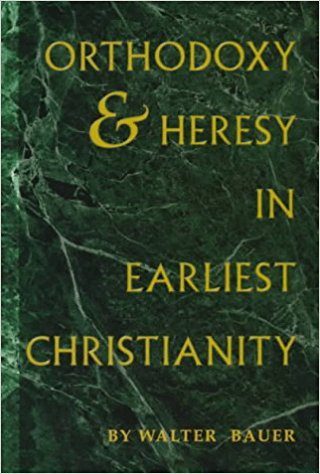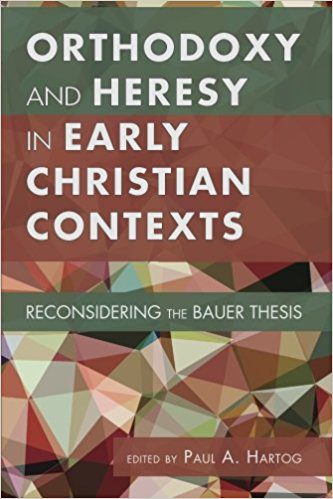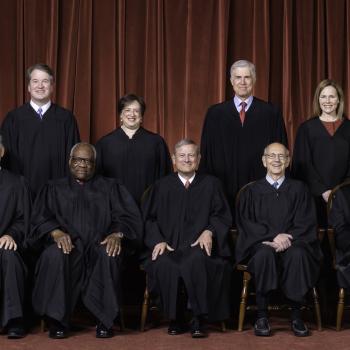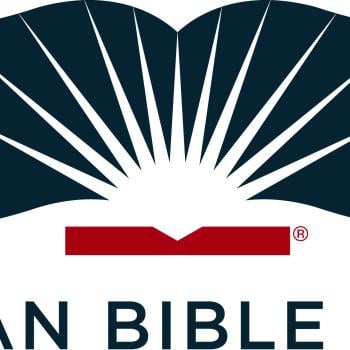This post is a very brief review of two books whose titles begin, Orthodoxy and Heresy.
 The most important, scholarly book about Jesus published in the 2oth century was Albert Schweitzer’s The Quest of the Historical Jesus (1906). The most important, scholarly book about Christian Origins published in the 20th century was Walter Bauer’s Orthodoxy and Heresy in Earliest Christianity (1934). Both of these scholars were German, and these two books were first published in the German language. Surprisingly, Bauer’s book was not translated and published in English until 1971. When that happened, his book gained much more attention, especially from scholars.
The most important, scholarly book about Jesus published in the 2oth century was Albert Schweitzer’s The Quest of the Historical Jesus (1906). The most important, scholarly book about Christian Origins published in the 20th century was Walter Bauer’s Orthodoxy and Heresy in Earliest Christianity (1934). Both of these scholars were German, and these two books were first published in the German language. Surprisingly, Bauer’s book was not translated and published in English until 1971. When that happened, his book gained much more attention, especially from scholars.
Walter Bauer is most known for his study resource A Greek-English Lexicon of the New Testament and Other Early Christian Literature (1957). It has been revised by others and is now in its third edition (2000). It is the #1 aid for knowing what words mean in the Greek New Testament and how they are used therein. All serious Bible students, no matter how much koine Greek they know, should have it in their library.
Bauer’s Orthodoxy and Heresy is a controversial book. It is massive study of the early church. Distinguished scholars generally regard it as iconoclastic. Bauer’s main thesis in this book is that, during at least the first two centuries of the Common Era, there were many Christianities. Thus, the Catholic dogma that its Church was monolithic early in history Bauer deems incorrect. A sub-thesis in Bauer’s book is that the Catholic Church’s three-tiered ecclesiological system (bishops-elders-deacons), which includes its papacy, was established later than the Church has claimed.
Bauer’s conclusion regarding these earliest Christianities in various localities is that what was later regarded by the Catholic Church as heresy was actually orthodoxy in those earlier times. For example, the back cover of my copy of Bauer’s Orthodoxy and Heresy (2nd ed. published by Fortress Press, 1971) reads, “Bauer takes issue here with the long dominant view that heresy in the first Christian centuries consistently represented a later perversion of an original orthodoxy. He argues that in some areas the initial form of Christianity was actually heretical according to later standards, and that orthodoxy as defined by the church councils triumphed at a relatively late date.” Scholars call this viewpoint of Bauer’s book The Bauer Thesis.
I think some of Bauer’s book is quite enlightening. But much of it gets a little boring because he goes into detail about Christianities in various localities. This subject can get confusing for the novice because of how Christians have defined, and thus used, the words “orthodoxy” and “heresy” prior to Bauer’s book. They defined “orthodoxy” just as it appears etymologically in Greek: ortho=right or accepted; doxa=opinion; thus “right opinion.” Heresy means belief or opinion that is contrary to orthodox opinion. But nowadays, most scholarly authorities on this subject treat the word “orthodoxy” amorally to refer merely to groups claiming to be orthodox, viz., the Catholic Church. Thus, these scholars do not mean that such groups actually do have the right opinion.
 An important book was published in 2015 by Wipf and Stock Publishers that challenges some of The Bauer Thesis. It consists of essays/chapters by ten scholars, with Paul A. Hartog as editor, and it is entitled Orthodoxy and Heresy in Early Christian Contexts: Reconsidering the Bauer Thesis. I recently finished reading this book very carefully.
An important book was published in 2015 by Wipf and Stock Publishers that challenges some of The Bauer Thesis. It consists of essays/chapters by ten scholars, with Paul A. Hartog as editor, and it is entitled Orthodoxy and Heresy in Early Christian Contexts: Reconsidering the Bauer Thesis. I recently finished reading this book very carefully.
It seems many of these contributing writers are conservative-thinking Christian scholars. They affirm some of The Bauer Thesis, such as his assertion there were more of a diversity of beliefs among the first Christians than previously was acknowledged. Their main objection to Bauer’s Thesis is that they allege it is based too much on speculation. Indeed, apart from the New Testament, the fact is that there are not a lot of facts available about what the earliest Christians believed. Patristic writings are much more sparse in the late first and entire second centuries compared to succeeding centuries. But there are two main issues that were important to me that I learned from this recent Orthodoxy and Heresy book, and that is all I will write about in this review.
First, Bauer did not treat early Jewish Christianity at all. That is surprising since much of Early Jewish Christianity supports Bauer’s Thesis. I had not noticed that in Bauer’s book because I read it many years ago, before I got interested in Early Jewish Christianity at a later time.
As I’ve said on this blog before, I have been a member of the Society of Biblical Literature since 1999, and I have only missed one of their Annual Meetings. When I first joined, The Historical Jesus Section of SBL was in full swing. It’s panel of about eight members included some of the most distinguished New Testament scholars in the world. This section was by far the most popular one to attend when scholars delivered papers and discussed them. One time I counted over 500 scholars attending one of the meetings. The panel included N. T. Wright, James Dunn, John Dominic Crossan, Marcus Borg, my friend Scot McKnight, and others. Ed Sanders was a member right before I joined.
But by 2010, scholarly interest in the historical Jesus–which had heated up for about thirty years and was somewhat spurred on by the Jesus Seminar–had waned. Another scholarly endeavor that was related to The Historical Jesus, and sort of took its place for a brief while, was Early Jewish Christianity. (This discipline has been bogged down somewhat for years over what seems rather mundane to non-initiates like me. It is a disagreement over definitions of terms like “Jewish Christians” or “Christian Jews.”)
These two disciplines–The Historical Jesus and Early Jewish Christianity–are related because they concern Christian Origins. Distinguished scholars of Early Jewish Christianity claim the beliefs of the early Jewish Christians were standard among all Christians during the first century and into the second. These beliefs were that God is numerically one, thus not triune, and that Jesus died and was raised from the dead as Savior, but he wasn’t God. Thus, these scholars maintain that later so-called “orthodoxy”–that God is three Persons and that Jesus, as one of those Persons, is God–was unknown in the first century among any Christians, either Jews or Gentiles. So, these authorities on Early Jewish Christianity affirm part of the Bauer Thesis, that what was later orthodoxy would have been heresy to all Christians who lived during at least the first century.
Second, another important thing I derived from this recent Orthodoxy and Heresy book is that the Church at Rome was not as influential during the second century and early third century as the Catholic Church historically has asserted. In fact, during the time of Tertullian, the church in North Africa was almost as influential as the church at Rome. This assessment by these scholars is contrary to Bauer’s Thesis, which says the Roman Church wielded much power and influence during that time.
This new information was important to me due to Tertullian. He was a lawyer who converted to Christianity and became a leading Christian apologist known mostly as a heresiologist. Thus, he used many legal terms in his theological writings, much of which attacked supposed theological heresy.
Turtullian lived in Carthage on the Mediterranean Sea, which is now located in Tunisia. He is the first patristic writer known popularly to have defined God as a trinitas. That is Latin for “trinity” since Tertullian wrote mostly in Latin. He was “the leading theologian of the West at the turn of the third century” (Orthodoxy and Heresy, 2015, p. 120).
Tertullian’s most well known book is Against Praxeas (published about 207). Praxeas was a monarchist who emphasized God’s unity as a monarch. Praxeas spent some time in Carthage teaching modalistic monarchianism (later Sabellianism and contemporary Oneness Pentecostalism). Tertullian says Praxeas taught, “the Father, the Son, and the Holy Ghost are the very selfsame Person” (Ante-Nicene Fathers: First Series, Chapter II). In Chapter III of this work, Tertullian objects to this by saying twice, which is rather strange to us moderns, that God is “Dispensation (of the Three in One).” This is the first time in patristic writings that “Three in One” appears and is applied to God.
Tertullian says concerning Praxeas and others like him, “They are constantly throwing out against us that we are preachers of two gods and three gods, while they take to themselves pre-eminently the credit of being worshippers of the One God,” which he then calls “heresy.” In Chapter IV of Against Praxeas, Tertullian clearly states that he believes in Jesus’ derived substance from, and essential subordination to, God. In fact, that is what all Christian apologists of the 2nd and 3rd centuries taught. He writes, “But as for me, who derive the Son from no other source but from the substance of the Father …” This teaching means that the Son is essentially subordinate to Father, so that they are not equally divine as the Catholic Church later decided at Nicea, in 325, and made the centerpiece of its Nicene Creed.
Then Tertullian writes about “the third degree in the Godhead, because I believe the Spirit to proceed from no other source than from the Father through the Son.” The last clause, “from the Father through the Son,” is one of the most famous in all of literature. It is called “the filoque clause.” The Roman Catholic Church seized upon it centuries later when it and the Orthodox Church divided into two separate entities, in 1054, over what is called “the procession of the Holy Spirit.”
Tertullian’s statements about God being a trinitas were also foremost when the Catholic Church developed its doctrine of the Trinity over a period of two and a half centuries. And another huge influence that Tertullian had in this development was his view that the Holy Spirit was an actual person. But he does not seem to have held this view until after he became a Montanist.
Even though Tertullian had a most profound impact on the Catholic Church’s theology, the Church never canonized him. Moreover, Tertullian was regarded by many Catholics as a heretic in his later life. It is because Tertullian became a Montanist. This Christian sect derived it origin from a Catholic priest named Montanus who lived in Phrygia, Asia Minor (present western Turkey). He was a millenarian who taught extreme asceticism, such as celibacy for married couples, emphasized prophesyings, spoke in tongues, and taught that Jesus was coming soon and that he would establish the New Jerusalem of Revelation 21-22 in Phrygia. This movement gained in popularity and had similarities to modern Pentecostalism.
I suspect that Tertullian came to believe the Holy Spirit is a person due to his increased focus on the Holy Spirit as a Montanist. I don’t know if this can be proved. Some of the contributors to Orthodoxy and Heresy provide much information about Tertullian’s strong influence on Catholic theology at Rome. In contrast, the standard view has been the church at Rome developed its theology and passed it on to the dioceses.
So, this recent Orthodoxy and Heresy affirms some of The Bauer Thesis and objects to other parts of it. I found this book to be quite engaging and informative.













